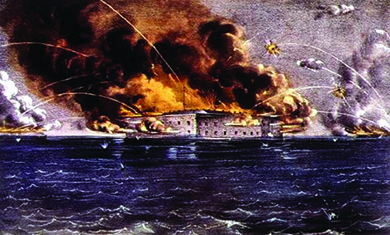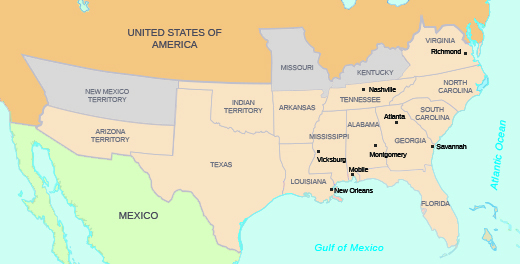| << Chapter < Page | Chapter >> Page > |
Read Lincoln’s entire inaugural address at the Yale Avalon project’s website. How would Lincoln’s audience have responded to this speech?
President Lincoln made it clear to Southern secessionists that he would fight to maintain federal property and to keep the Union intact. Other politicians, however, still hoped to avoid the use of force to resolve the crisis. In February 1861, in an effort to entice the rebellious states to return to the Union without resorting to force, Thomas Corwin, a representative from Ohio, introduced a proposal to amend the Constitution in the House of Representatives. His was but one of several measures proposed in January and February 1861, to head off the impending conflict and save the United States. The proposed amendment would have made it impossible for Congress to pass any law abolishing slavery. The proposal passed the House on February 28, 1861, and the Senate passed the proposal on March 2, 1861. It was then sent to the states to be ratified. Once ratified by three-quarters of state legislatures, it would become law. In his inaugural address, Lincoln stated that he had no objection to the amendment, and his predecessor James Buchanan had supported it. By the time of Lincoln’s inauguration, however, seven states had already left the Union. Of the remaining states, Ohio ratified the amendment in 1861, and Maryland and Illinois did so in 1862. Despite this effort at reconciliation, the Confederate states did not return to the Union.
Indeed, by the time of the Corwin amendment’s passage through Congress, Confederate forces in the Deep South had already begun to take over federal forts. The loss of Fort Sumter , in the harbor of Charleston, South Carolina, proved to be the flashpoint in the contest between the new Confederacy and the federal government. A small Union garrison of fewer than one hundred soldiers and officers held the fort, making it a vulnerable target for the Confederacy. Fire-Eaters pressured Jefferson Davis to take Fort Sumter and thereby demonstrate the Confederate government’s resolve. Some also hoped that the Confederacy would gain foreign recognition, especially from Great Britain, by taking the fort in the South’s most important Atlantic port. The situation grew dire as local merchants refused to sell food to the fort’s Union soldiers, and by mid-April, the garrison’s supplies began to run out. President Lincoln let it be known to Confederate leaders that he planned to resupply the Union forces. His strategy was clear: The decision to start the war would rest squarely on the Confederates, not on the Union. On April 12, 1861, Confederate forces in Charleston began a bombardment of Fort Sumter ( [link] ). Two days later, the Union soldiers there surrendered.

The attack on Fort Sumter meant war had come, and on April 15, 1861, Lincoln called upon loyal states to supply armed forces to defeat the rebellion and regain Fort Sumter. Faced with the need to choose between the Confederacy and the Union, border states and those of the Upper South, which earlier had been reluctant to dissolve their ties with the United States, were inspired to take action. They quickly voted for secession. A convention in Virginia that had been assembled earlier to consider the question of secession voted to join the Confederacy on April 17, two days after Lincoln called for troops. Arkansas left the Union on May 6 along with Tennessee one day later. North Carolina followed on May 20.
Not all residents of the border states and the Upper South wished to join the Confederacy, however. Pro-Union feelings remained strong in Tennessee, especially in the eastern part of the state where slaves were few and consisted largely of house servants owned by the wealthy. The state of Virginia—home of revolutionary leaders and presidents such as George Washington, Thomas Jefferson, James Madison, and James Monroe—literally was split on the issue of secession. Residents in the north and west of the state, where few slaveholders resided, rejected secession. These counties subsequently united to form “West Virginia,” which entered the Union as a free state in 1863. The rest of Virginia, including the historic lands along the Chesapeake Bay that were home to such early American settlements as Jamestown and Williamsburg, joined the Confederacy. The addition of this area gave the Confederacy even greater hope and brought General Robert E. Lee, arguably the best military commander of the day, to their side. In addition, the secession of Virginia brought Washington, DC, perilously close to the Confederacy, and fears that the border state of Maryland would also join the CSA, thus trapping the U.S. capital within Confederate territories, plagued Lincoln.
The Confederacy also gained the backing of the Five Civilized Tribes, as they were called, in the Indian Territory. The Five Civilized Tribes comprised the Choctaws, Chickasaws, Creeks, Seminoles, and Cherokees. The tribes supported slavery and many members owned slaves. These Indian slaveholders, who had been forced from their lands in Georgia and elsewhere in the Deep South during the presidency of Andrew Jackson, now found unprecedented common cause with white slaveholders. The CSA even allowed them to send delegates to the Confederate Congress.
While most slaveholding states joined the Confederacy, four crucial slave states remained in the Union ( [link] ). Delaware, which was technically a slave state despite its tiny slave population, never voted to secede. Maryland, despite deep divisions, remained in the Union as well. Missouri became the site of vicious fighting and the home of pro-Confederate guerillas but never joined the Confederacy. Kentucky declared itself neutral, although that did little to stop the fighting that occurred within the state. In all, these four states deprived the Confederacy of key resources and soldiers.

The election of Abraham Lincoln to the presidency in 1860 proved to be a watershed event. While it did not cause the Civil War, it was the culmination of increasing tensions between the proslavery South and the antislavery North. Before Lincoln had even taken office, seven Deep South states had seceded from the Union to form the CSA, dedicated to maintaining racial slavery and white supremacy. Last-minute efforts to reach a compromise, such as the proposal by Senator Crittenden and the Corwin amendment, went nowhere. The time for compromise had come to an end. With the Confederate attack on Fort Sumter, the Civil War began.

Notification Switch
Would you like to follow the 'U.s. history' conversation and receive update notifications?